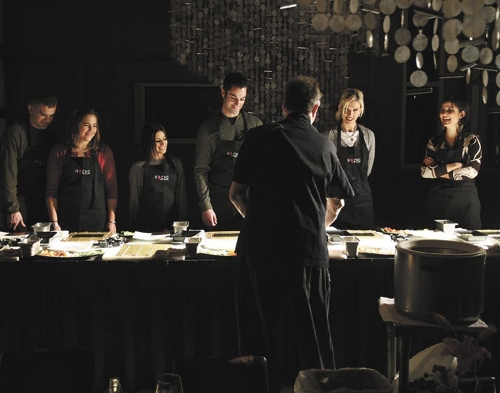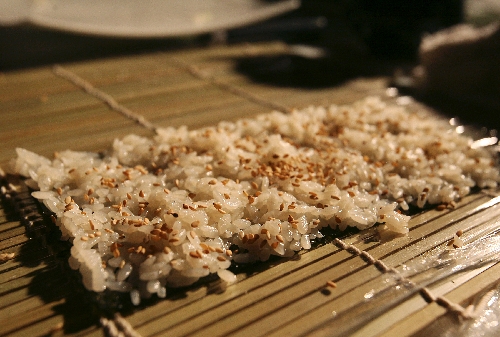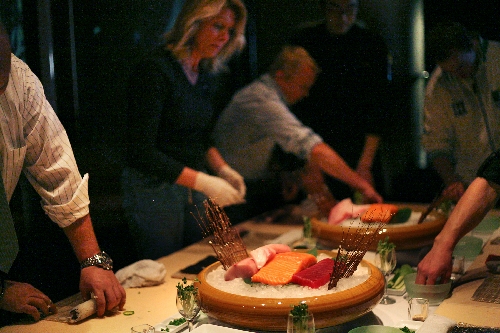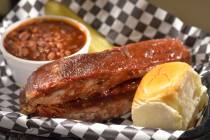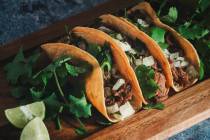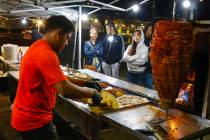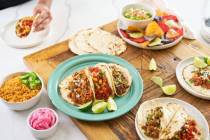Students learn the art of sushi making at local restaurants
Anyone who has ever sat at a sushi bar for an hour or so doubtless left impressed with the mastery of the sushi chefs. In what seems like mere seconds, they cut fish into perfect pieces, choose the appropriate fillings and garnishes and, perhaps most impressively, manage to get the rice to stick to the sheets of nori, or seaweed. These are skills that are way beyond the reach of rank amateurs, right?
Actually, the answer to that might surprise you -- until, that is, you've watched a group of wet-behind-the-ears beginners create pretty impressive sushi rolls on their first try, at classes in at least two Las Vegas restaurants.
Most of the students, it seemed, knew what they were getting into.
"It would be catastrophic to do it ourselves," said Danielle Lechner, speaking from the vantage point of someone who'd just made a near-perfect California roll on her first try, at Hachi at Red Rock Resort.
The class was led by room chef Martin Swift, who trained with master sushi chefs in London. The classes, which usually are on the third Thursday of each month, are "full all the time, because it's such a novel thing that we do," he said.
Swift started the class session by building the confidence of his students: "You will be good enough by the time you leave here to have a sushi-rolling party."
The sushi rice -- obviously a critical element -- had been cooked in advance, because its preparation would take up the entire class time, he said. Each student received a book (as well as an apron) in their goodie bag to provide some rice-cooking guidance when winging it at home.
Swift set to work demonstrating a California roll, first placing a sheet of nori, rough-side up, on the flat side of a bamboo sushi mat.
Most important, he said, is the control of water on the hands; if there's too much water the rice won't stick to the nori, but if there's too little, it'll fly around the room. Swift dipped his hands and clapped them to remove the excess water, making a sound that's characteristic of sushi bars. Reaching into a rice cooker, he formed a "small-baseball, large-racquetball" ball of rice.
Deftly, Swift placed the ball of rice at one end of the nori sheet and used his fingers to feed it across the nori.
"I've basically covered half the nori already," he said.
Then Swift pulled the rice -- never pressing or squashing -- across the sheet, evening the edges and filling in any blank areas. He sprinkled it with toasted sesame seeds for color and flavor and because they help keep the rice from sticking to fingers. He then flipped the sheet over, spread a little wasabi across the center and added crab sticks and avocado. Then he lifted up on the mat, pressed down and rolled -- but not entirely.
"If you don't see any nori, you've gone too far," he said. He lifted the mat to reveal a perfect roll, then slid it to each side of the mat and used his hand to even the ends. The proper shape of a sushi roll, Swift told the students, is flat on the bottom and straight on the sides, with a domed top.
Then it was the students' turn. With a "go for it," they chose stations and went to work, wetting and clapping and bending over their task.
They spread. They pulled. Then they flipped -- and voila! All of the rice stayed with all of the nori sheets. The students filled and rolled and ended up with pretty admirable California rolls.
"Tell me how good you feel right now," Swift said.
Time for another roll. This one would have ingredients on the outside, so no sesame seeds. They pulled, spread and turned. They filled and rolled. Then they alternated avocado slices and pieces of ebi -- shrimp, cooked flat and seasoned -- on top. Swift showed how to place a sheet of plastic wrap over the top before rolling with the sushi mat to mold the shrimp and avocado right into the rolls. He cut the roll with plastic wrap in place to keep things together, then removed the sheet in one piece.
Swift also showed the students how to make a hand roll, and covered basic tips and etiquette: When eating sushi, put just a touch (not a puddle) of soy sauce into the dish for dipping. If you want a hand roll, be sure to order it at the sushi bar, because they don't travel well. For sushi-grade fish he recommended Whole Foods Market. For supplies, he recommended the International Marketplace at 5000 S. Decatur Blvd., and it was there that Sally Golembiewski planned to go as soon as possible.
Golembiewski said that for two years she'd wanted to take the class, and signed up when she and her husband came in for dinner in December.
"I think I can do it," she said after the class. "I need to practice."
"I feel pretty good about it," said Lechner, who was attending with her husband, Scott. They'd recently been transferred to Nellis Air Force Base and chose the class as a date-night diversion.
Across town and a few days later, Hayes Swope and Yuki Ieto led a Sushi & Sake 101 class at Sushisamba at the Palazzo. Swope, who's a sake sommelier and the company's regional director of operations, led a tasting of five sakes, discussing the extensive history of sake, the various types and other information. With the sakes, students were served a selection of Sushisamba's signature dishes.
And then it was time for them to try rolling their own sushi. Ieto took more of a Mother Earth approach, displaying a whole gutted (and bled-out) kampachi, and telling the students how to check for freshness with the time-honored clear-eyes and pink-gills tests. He then finished cleaning the fish and cutting it, with Swope noting that each piece of fish was cut with a tiny lip to retain the proper amount of soy sauce, with the size of the lip determined by the type of fish.
Scott and Elaine Harris, who blog at VinoLasVegas.blogspot.com and The Cuisineist.blogspot.com, were among the members of the class.
"I think it's wonderful," she said "-- a great education."
Jessica Shay of Los Angeles said the class was a gift from her husband, Ken (who doesn't normally eat sushi but maintained that he was keeping an open mind), in honor of the visit of her brother, Shayan Tamayo, of New York City. All three of them enrolled. Tamayo said he was pretty pleased about what he had accomplished, although he knew "I need to get better."
Jessica Shay's reaction, though, was unequivocal.
"I'm over the moon," she said, munching happily. "I never thought I could make a sushi roll as well as this."
Contact reporter Heidi Knapp Rinella at hrinella@review journal.com or 702-383-0474.
STEPS TO MAKING SUSHI ROLLS:
1. Wrap bamboo sushi mat in plastic wrap. Turn flat side up.
2. Place a sheet of nori on the mat, with the rough, matte side facing up.
3. Wet hands, clapping to remove excess water. Form a ball of sushi rice smaller than a baseball but larger than a racquetball.
4. Spread sushi rice across the nori, "feeding" it out with the fingers, neither squashing nor pressing. Pull the rice down to cover the entire sheet, filling in any blank areas and evening up the edges.
5. Flip the sheet over and spread the nori with a small amount of wasabi. Add fillings.
6. Lift the sushi mat and roll carefully, gently pressing down, until the ends of the roll meet.
7. Unroll mat and slide sushi roll to one side, patting the end with a damp hand to even it, and then the other.
CLASS INFORMATION:
Sushisamba's Sushi & Sake 101 begins at 1:30 p.m. every other Saturday (including this Saturday) at the restaurant at the Shoppes at the Palazzo. It's $100. To register, call 607-0700 or visit ww.Sushisamba.com.
Hachi's sushi-making classes begin at 6:30 p.m. on the third Thursday of each month (except for the next class, which is Feb. 24) at the restaurant at Red Rock Resort. They're $85. To register, call 797-7054.



